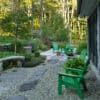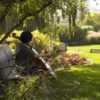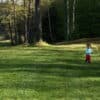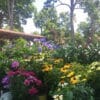Having an inquisitive baby crawling around outside really raises one’s awareness about the dangerous vegetation lurking there. Here are some potent plants that are on my radar these days:

Deadly nightshade’s name certainly hints at its toxicity! Illustration: wikipedia.org; Photo: Poisonous Plants of Oregon. Amended: An alert reader notified us that the photo on the right is actually bittersweet, or common, nightshade. See the Comments section below for more information!
A few months ago, I was sitting in my garden with my then-six month old baby and spied no less than nine poisonous plants within an arm’s reach. Some of these plants were so poisonous that their consumption could result in sickness, convulsions, or death. Was that garden fenced, you ask? Were there posted warning signs? If nothing else, was child services contacted?!? Well I don’t know about the warning signs or child services, but the garden is indeed fenced… to keep out the deer, rabbits, chickens, and moose that is. This garden in question is actually my vegetable garden, and it is a dangerous place indeed.

Both the leaves and stems of tomatoes and potatoes contain the chemical “Glycoalkaloid” which can cause nervousness and stomach upsets. Photos: L: worldcommunitycookbook.org; R: wikipedia.org.
The poisonous plants I had spied were domesticated varieties of tomatoes, potatoes, rhubarb, kidney beans, apples, and asparagus, along with the uninvited milkweed and deadly nightshade (which is as toxic as the name suggests!). Except for the deadly nightshade, all of these plants contain certain parts (the leaves, seeds, sap, or flowers) that are considered fit for consumption, and simultaneously, other parts that are poisonous. With the milkweed and rhubarb, the same part of the plant that is edible becomes inedible as the plant matures. How sneaky! You just can’t trust the Plant Kingdom.

Rhubarb’s leaves are inedible while their stems are a culinary delight. Milkweed contains the toxin Galitoxin in all of its vegetative parts. Photos: L: cookinglight.com; R: thewildlifeporch.com.
Just the other day, one of my colleagues was reprimanded for allowing a poisonous plant to enter the sanctified walls of an otherwise nontoxic “children’s” garden. I felt as though this reprimand was a bit naïve, as if the assumption was that all other plants in the larger grounds of the garden were somehow safe and otherwise edible. In the case of this place, the grounds surrounding the new garden were already filled with yews, rhododendrons, and scores of potentially lethal unknowns. This is typical of most wild and domesticated landscapes. In a world of dangerous greens, children should be taught at an early age that most plants are poisonous. Only some are not. Just as we don’t leave children alone in a busy street without supervision, it is unsafe to leave children unattended in a garden, field, or forest until they are old enough to control their hand-to-mouth urges.
Short of walling off all gardens, fencing in all wild areas, or restricting our landscaping materials to the innocuous and inedible plastic and concrete, there is not much we can do to protect ourselves from these dangerous greens other than educate ourselves about the edibles or otherwise keep our mouths taped shut.

Apple seeds contain cyanide and kidney beans carry the toxin phytohemagglutinin (PHA). Photos: L: University of Wisconsin; R: worldevergreen.com.
No more than we should drain the oceans for fear of drowning or cut down all of the trees for fear of falling out of them, we should not and cannot get rid of all poisonous plants. We should also not deceive ourselves into thinking that we can make a poison-free garden. It is too easy to make a mistake. With so much of the design already compromised in the name of safety, it would be a shame to restrict the plant palette too. Some of my favorite plants are poisonous!
Be aware of the toxic qualities of the following popular garden plant genera:
Aconitum (Monkshood), Colchicum (Autumn Crocus), Convallaria (Lily-of-the-Valley), Cotoneaster, Datura (Angel’s Trumpet), Dicentra (Bleeding Hearts), Delphinium (Larkspurs), Digitalis (Foxglove), Euphorbia (Spurge), Hellebores (Lenten Rose), Laburnum (Golden Rain Tree), Lantana, Lilium (Bulb Lilies), Narcissus (Daffodils), Podophyllum peltatum (Mayapple) Ricinus (Castor Bean).
Also be on the lookout for species of these commonly grown (but poisonous) woody plants:
Aesculus (Horse Chestnut), Daphne, Kalmia, Ligustrum (Privet), Prunus (Cherry), Rhododendron, Rhus, Sambucus (Elderberry), Taxus (Yew), Wisteria.
This is just a short list, of course. There are many more plants to watch out for. When in doubt keep the plant out of your mouth and the mouths of the babes, and for Heaven’s sake, don’t eat the garden.






A post worth keeping for reference. Great information and I liked the title too.
very important material…sometimes one wonders how the deer get away with munching down on several of these poisonous plants.
Erica Bowman: Thanks for the perfect post-Halloween tale.
Your readers will appreciate Amy Stewart’s recent book “Wicked Plants.”
http://www.amystewart.com/wickedplants.html
Amy Stewarts “Wicked Plants” is illustrated by local (Brattleboro, VT) printmaker Briony Morrow-Cribbs with lovely botanical etchings:
http://www.brionymorrow-cribbs.com/index.html
One of our readers–a Massachusetts Master Gardener–caught our error in the first photo caption above and shared some helpful information about nightshades. The website we cited above (and many other plant identification websites) incorrectly ID’s common nightshade, with its pretty purple flowers, as deadly nightshade, which has white flowers and is not typically found in our part of the country.
The plant in Erica’s garden is most likely the very toxic Eastern black nightshade (Solanum ptycanthum), seen here: http://www.ppws.vt.edu/scott/weed_id/solpt.htm.
Thanks, Sonja!
Very helpful remarks! Easy to forget how cautious one must be with plants, thanks for the reminder!